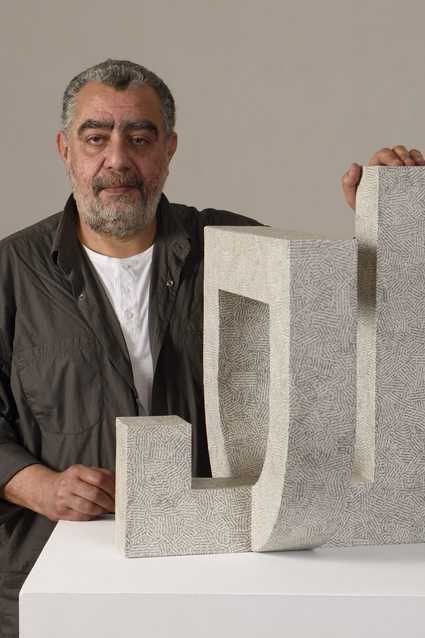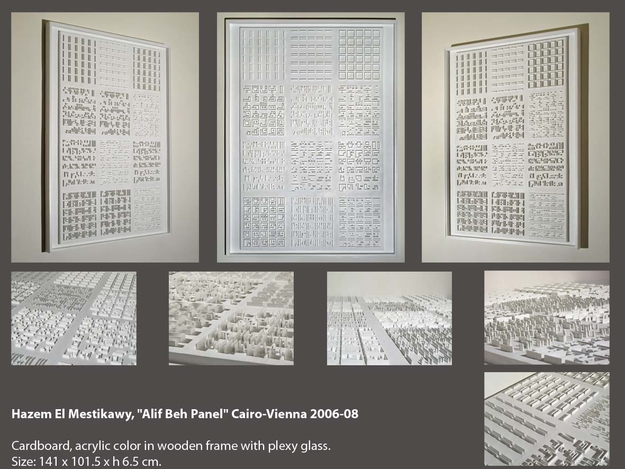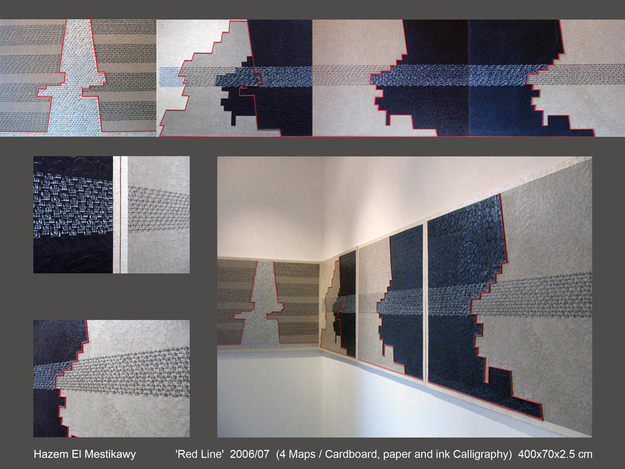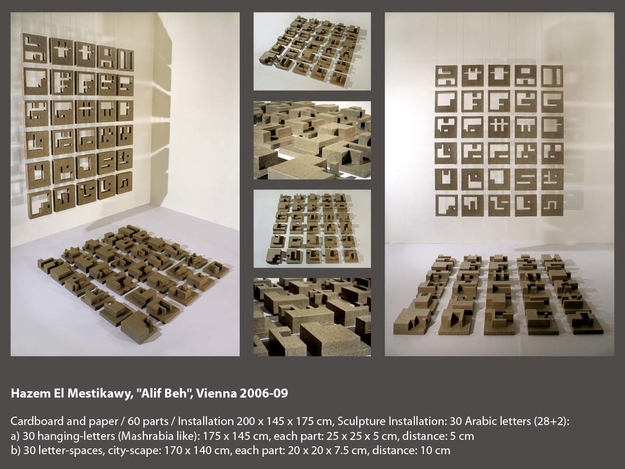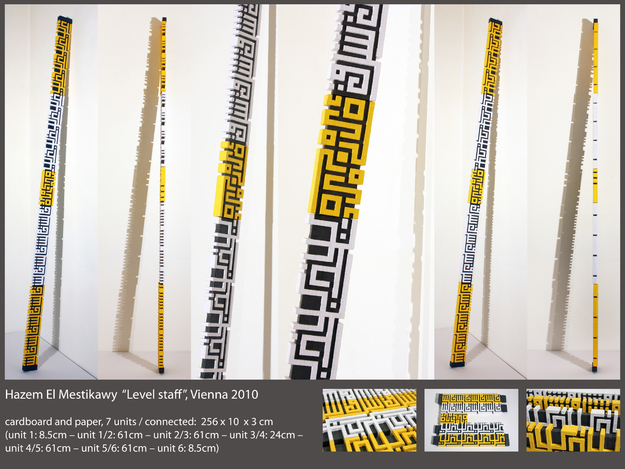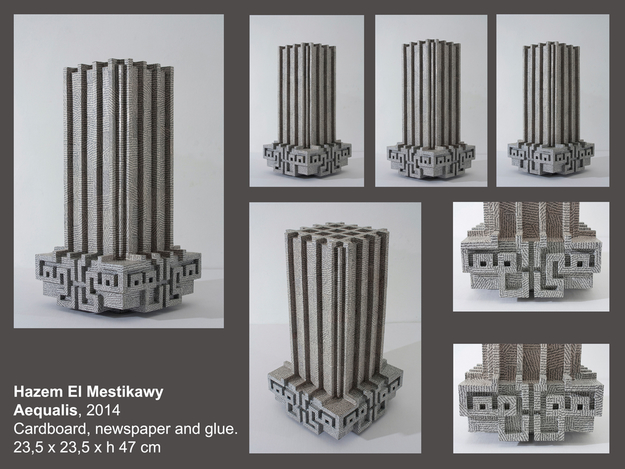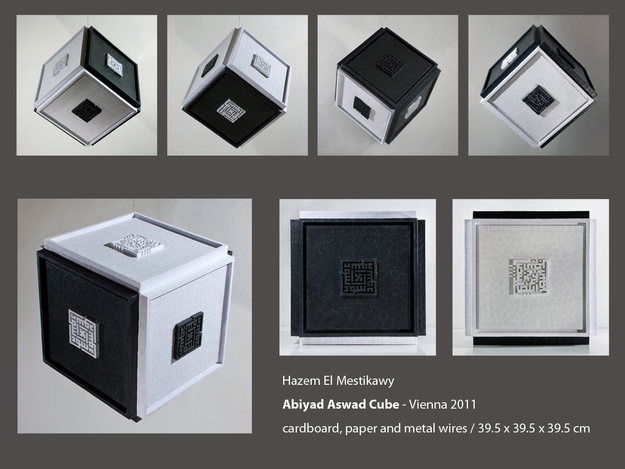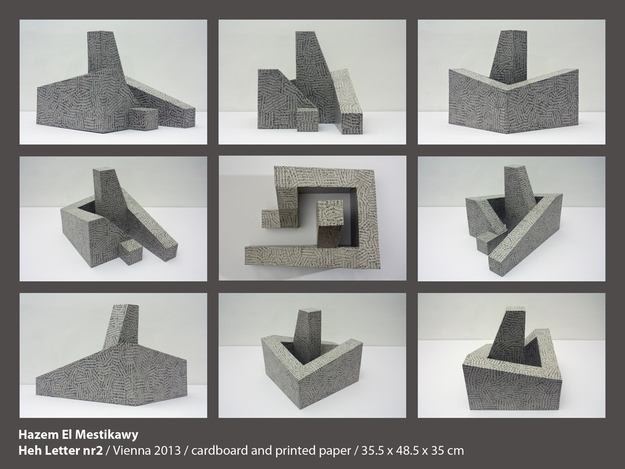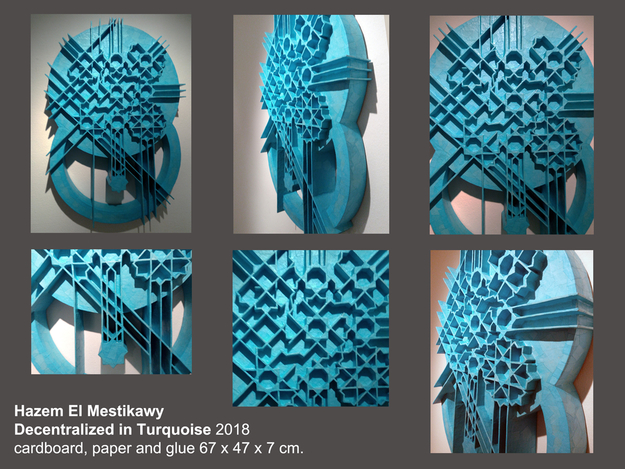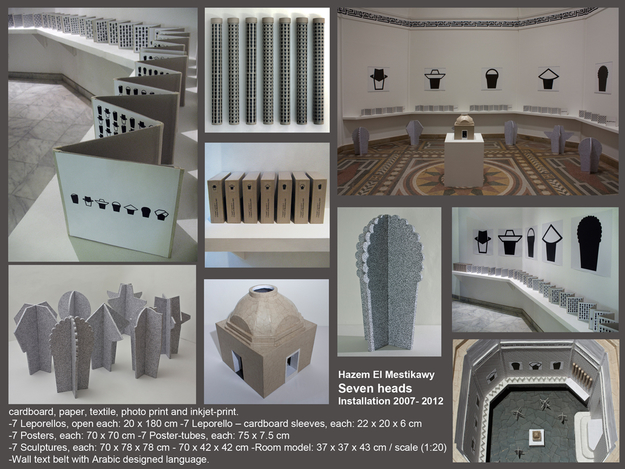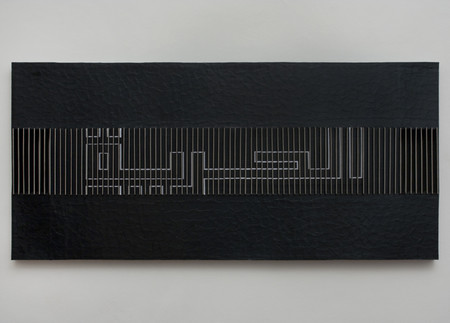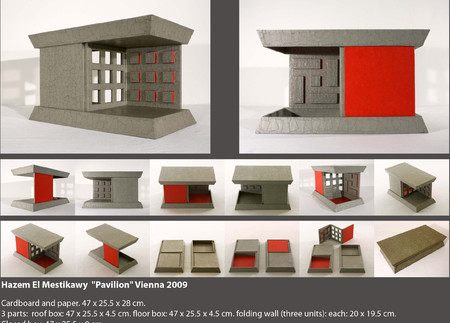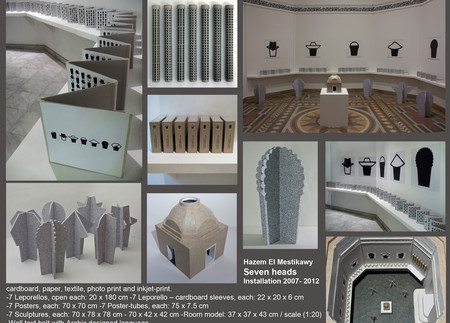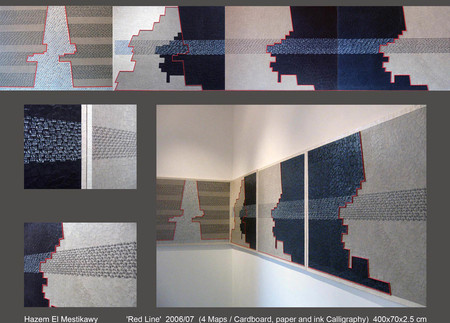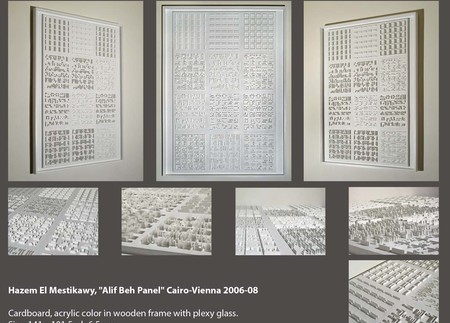El Mestikawy made several solo exhibitions in Austria, Egypt and Switzerland, and participated in several group exhibitions arround the world since 1989, as:
"Miniature Erotic Art", Aarau-Switzerland 1997 / "Dimensions" Cairo Atelier-Egypt 1998 / Winner of the Grand Prize of Installation, 11th Salon for youth Cairo 1999 / "8th Cairo International Biennale" 2001, Egypt / "Art out of the suit-case", Art Museum Olten, Switzerland 2004 / "Trap-Labyrinth", NÖ-Documentation Center of Modern Art, St. Pölten, Austria / "Image AND Letters", Gallery Atrium ed Arte Vienna, Austria 2005 / "Type Faces" raumim puls, Waidhofen/Ybbs Museum, Austria 2006 / "Baggage" Alexandria Atelier, Egypt / "Occidentalism" contemporary artists from Egypt, Cairo-ET / "Black Sheep" kunst treppe gallery, Winterthur-Switzerland / "What's Happening Now?" The Art Palace, Cairo-Egypt 2007/ From Athens to Marseille to Cairo" Palais Des Arts, Marseille-France / Collection of North Carolina Museum of Art, Raleigh, NC-USA./ "The Last Book" National Library of Argentina, Buenos Aires. / "Aesthetics and Science" Austrian Academy of science, Vienna-Austria / Grand Prize of the"13th Asia Art Biennale", Dhaka-Bangladesh.2008/ "Gathering 2009", Cairo-Atelier, Cairo-Egypt. / "Undercurrent changes", Gallery Art Sawa, Dubai-UAE./ Solo exhibition "Alif Beh", Galerie Atrium ed Arte, Vienna-Austria. / "Modulus", Oxyd Art Spaces, Wülflingen/Winterthur-Switzerland.- "Shoes Or No Shoes", Museum collection, Kruishoutem-Belgium. 2010 - "AGENDA", Alexandria Bibliotheca Gallery, Alexandria-Egypt.- "Why Not?", Palace of Arts, Cairo-Egypt. - "3rd Kokaido Art Show", Iwate Prefecture Civic Centre, Morioka, Iwate-Japan.- "New Formalism", Bidoun Magazine project, Dubai Art Fair, UAE.- "The Last Book", National Library, Zurich-Switzerland.- "Land of the Hyperreal", Contemporary Egyptian Art, Memorial Jose Martì Revolution Square, Center City, Havana-Cuba.- "About Spaces", Karim Francis Contemporary Art Gallery, Cairo-Egypt. / 2011 - "Oesterreich ist schoen, oder?", book project / Swiss in Austria, Christoph Braendle (Ed.), Vienna-Austria. - "AGENDA 2011", Alexandria Bibliotheca Gallery, Alexandria-Egypt.- "Still Vaild", Contemporary Egyptian Art, Sharjah Art Gallery - AUC, Cairo-Egypt.- "Jameel Prize", short list artists exhibition, Victoria & Alberts museum, London-UK. - "Paper x Paper", Gallery Almarkhiya, Doha-Qatar.- "Fifteen Ways to Leave Badiou", book project, ACAF, Alexandria-Egypt. - "Line", Gallery Atrium ed Arte, Vienna-Austria. - "Shokoul", Solo exhibition, Sharjah Art Museum, Sharjah-UAE. / 2012 - "2nd Jameel Prize", short list artists exhibition, Institut du Monde Arabe, Paris-France and Casa Arabe, Madrid-Spain.- "Structure & Immateriality", Kunstverein Kärnten/Art Society Carinthia,Klagenfurt-Austria.- Hazem El Mestikawy & Jos van der Beek, AB Gallery Zurich-Switzerland. - "Supercluster - Cerveau Morille", CAN Art Center, Neuchâtel-Switzerland. - "Time(less) signs / Contemporary exhibition in reference to Otto Neurath"k/haus Künstlerhaus Wien, Vienna-Austria.- "2nd Jameel Prize", short list artists exhibition, Arts Centre in Stanford University, California (December 2012 - March 2013)./ 2013 - "Egyptian Art Today", AB Gallery, Luzern-Switzerland. - "Transparency as an artistic topic", Oxyd Art Spaces, Winterthur-Switzerland. - "2nd Jameel Prize", short list artists exhibition, San Antonio Museum of Art, South Texas - USA. - "drawing! drawing! ", k/haus-Künstlerhaus Wien, Vienna-Austria.- "Transalpin- artists from Vienna", sihlquai55 visarte, Zürich-Switzerland. - "art/fabric - material/materiality", basement Wien, Vienna-Austria./ 2014 - "Calligraphical Spaces", Solo exhibition, Sharjah Calligraphy Biennial, American University of Sharjah- UAE. - "Mapping the World - Sich die Welt erschließen" Exhibition NöART: Museum Orth an der Donau – Haus der Kunst Baden –Ziersdorf - Neulengbach - Wien, Austria. - "Calligraphical Spaces", Solo exhibition, Sharjah Expo, Sharjah-UAE - "basis.lager 3", basis wien Vienna-Austria.- "Verses & Impressions" - Al Markhya Gallery, Doha - Qatar. - "Timeless Signs" Austrian Culture Center, London - GB. - "KO_OP Salon 69" basis wien, Vienna - Austria. - "Silver Jubilee of the Youth Salon" - Palace of Arts, Cairo - Egypt. - "Jameel Museum" collection - Dubai-UAE. / 2015 - "VISUAL UTTERANCE" Cube Arts Gallery, Dubai - UAE.- "AGENDA" Alexandria Bibliotecha, Egypt. - "Juxstaposition" solo show, gallery Art Talks, Cairo - Egypt.- "Mapping the World " / NöART, Dorfmuseum Roiten, Rappotenstein-Austria - Solo Show, Wekalet Behna, Alexandria - Egypt. - The National Ehibition, Art Palace, Cairo - Egypt. - Somthing Else - International group show - Darb 17/18 Cairo - Egypt/ 2016 - Cairo Salon 57 - Palace of Art Cairo - Egypt - CARAVAN / ANKH (the key of life) Nile gallery Cairo-Egypt - 7th Internation Artist Book Biennale - Alexandria Bibliotheca - Egypt - The National Ehibition, Art Palace, Cairo - Egypt. - CARAVAN / ANKH (the key of life) London - UK & New York - USA - East West / Gallery Demouzy Contemporary, New York - USA. - Malakout / Contemporary Calligraphy, Ward gallery Dubai - UAE. - Sculpture NOW / Darb 17/18 Cairo - Egypt./ 2017 - Sculpture NOW / Fine Arts Museum, Alexandria - Egypt.- Selection Middle East Art, Ward gallery, Dubai - UAE - L'atelier Alexandria Salon - Egypt. - "Alif Beh" Project Space Art Jameel, Dubai - UAE. - “77” H.Harb & H.El Mestikawy, Gallery Ward, Dubai. / 2018 - Cairo Salon (drawings) Art Palace, Cairo, Egypt. - “Magaz” Gallery Ward, Dubai – UAE. - “Dakar Biennale” Darb 17/18 Pavilion, Senegal. - “Octagon” group show, Misr Gallery, Cairo – Egypt. - Sculpture Salon, Art palace, Cairo – Egypt. - "Concrete Poetry" solo show at the AUC, Cairo - Egypt. - "Nothing Vanishes Everything Transforms" Manial Palace, Cairo - Egypt. - "Something Else" Off Cairo Biennale, Darb 17/18, Cairo - Egypt. - "Telling Tales" Founoun Gallery, Beirute - Lebanon. / 2019 - AGENDA" 12th _ Alexandria Bibliotecha, Egypt. - “Five by Five” Nile art gallery, Cairo – Egypt. - “Shara” Hafez Gallery, Jedda – KSA. - “Cairo International Biennale” Cairo – Egypt. - “The 29th Letter of the Alphabet” Art d’Egypte & Mashrabia Gallery, Cairo – Egypt. - “Contrasts in Harmony” Misk art week, Riyadh – KSA.- “Abu Dhabi art fair” Art d’Egypte & Karim Francis art gallery, UAE./ 2020 - AGENDA, group exhibition, Alexandria Bibliotheca-Egypt. - 1-54 African Art Fair, Marrakech. - “Molecules” with Noha Nagui, Egyptian Culture Center, Paris. - “Contemporary Presence” group exhibition, French culture Centre, Alexandria-Egypt. - Cairo Salon59, Art Palace, Cairo – Egypt. / 2021- “Humans and Else” group show, Magdoub art gallery, Cairo – Egypt. - “Doko Aljodran” for Palestine, Art Talks Gallery, Cairo – Egypt. - Duo Show with “Keizer” by Mashrabia Gallery at Villa Gabrilla_ Cairo. - The 42 National Ehibition, Art Palace, Cairo - Egypt. - “Tangled Structures” The Factory, CIAD – Cairo International Art District,a project by Art D’Ègypte.- “Groovy Modulus”, Solo show at Picasso East art gallery, Cairo-Egypt. - Art Moderne & Contemporian African_Bonhams Auction, Paris-France./ 2022 - AGENDA, group exhibition, Alexandria Bibliotheca – Egypt. - Investec, Cape town Art Fair, South Africa. - “3031 Art Fest. Darb17/18, Cairo – Egypt.
Hazem El Mestikawy Museum Collections
- Museum of Modern Egyptian Art 1997 & 1999 & 2018
- North Carolina Museum of Arts, USA. 2008
- SONS , Belgium, EU 2009
- Jameel museum and center if Arts, Dubai, UAE 2014 & 2016
Identities of Perfection
The practice of Hazem el Mestikawy swarms around the realms of physics, architecture, engineering, sculpture, and visual tricking. Trained initially in the traditional mediums of sculpture, he plays with light and shade, with volume and its surrounding space while tackling the sculptural form; he skilfully probes the opposing forces of the geometrical and the organic.
In his sculptural masses, el Mestikawy does not stop with elements that satisfy regular sculptors, as he pushes the boundaries of the sculpture discipline to create site specific installations, to make it difficult even for the specialist to identify the works: they are sculptures, installations, and definitely inspired and influenced by architecture. What adds to the visual mystery is his attention to the details of his surfaces; he juxtaposes again several visual opposing surface effects: textural versus smooth, warm versus cool, legible textual versus flat monochromatic.
At historian, critic and curator Kathrin Frauennfendelder (1) describes el Mestikawy’s work as having very personal specificities: “the theme of reversing the negative and the positive, the subject of opening and closing, covering and uncovering”, to her there is a "secret of space".
On the concept level, we can confidently describe el Mestikawy’s practice as having ingeniously assimilated both his ancient Egyptian and Islamic art and architecture, as well as the contemporary minimal art philosophies; this cumulative assimilation leads el Mestikawy to deconstruct, or rather dismantle centuries-old motifs that are embedded in Egyptian and Middle East cultures, be it arabesque mashrabeyyas and/or geometrical patterns based on the recognizable forms of the square, triangle, circle and rectangle to create works that are both sophisticated and accessible.
The intriguing aspect of el Mestikawy’s practice is his insistence to work with cardboard and cartonage paper-based materials; this use of ephemeral material that needs particular care in handling, exhibiting, maintaining and conserving is unique, since nearly the entirety if his inspiring references, be it ancient Egyptian, Islamic or minimal art, are all conceived and constructed in eternal material: concrete, stone, treated wood or metal.
Art historian and curator Kinsey Katchka perceives Hazem el Mestikawy’s projects as clearly resonating with “Sufi philosophy, most markedly that of mystical numerology.” She probes el Mestikawy’s project Nine Squares and sees him investigating this mystically significant configuration of 9, citing such intensive attention to a single form as an expression of singular devotion (2).
Mestikawy’s research in form entails continuous construction-deconstruction process, eliminating along the way many details, a process reminiscent of ancient Egyptian sculpture, where details were abstracted ingeniously without any loss of visual narrative, a trait that gave the ancient Egyptian sculpture its distinct specificity from other Mediterranean (Greek or Roman) sculpture, though rich in detail but is not more informative than the Egyptian. The Egyptian colossal sculpture has always been identified and characterized by the simple yet powerful lines that transform the tons-heavy stone mass into perfect portraiture with the least details. The aesthetics of such simplification comes back today in total appreciation, now we have 50 years of intellectual programming in contemporary art.
Several projects recruit the process of abstraction and elimination to dig for the essential of the form, the minimal of shape that would visually express and deliver an effective visual message.
In one recent project el Mestikawy work with Arabic alphabets; in his omnipresent obsession of simplification, elimination, reduction and abstraction, one can immediately relate this process, and its outcome, to the ancient history of the early ancient Egyptian dynasties, where the sophisticated hieroglyphic alphabets were simplified to the more user-friendly hieratic style of writing through elimination of detail and form abstraction.
Though the artist’s simplification / abstraction process may seem supernaturally genetic then, reality is that el Mestikawy, like many Egyptian artists who recently attained international stature, got his visual and technical skills through conscious formal and informal training and labor, as well as through the thousands of subliminal messages delivered by the detritus of cumulative imaging that is branded with Egypt, ancient and contemporary; simplified tomb and temple paintings mingled with contemporary naïve-yet-narrative home wall painting and aggressive contemporary street advertising billboards, images of ancient sculpture mingled with naïve touristy replicas, and above all: perfect eternal ancient temple architecture juxtaposed against very fragile and ephemeral poor housing of clumsy (or no) architecture.
The ancient aspect of el Mestikawy, as Frauennfendelder and Katchka have noticed, is linked and related to minimal art in its near-industrial perfection, though the uniqueness in his work lies in an integral difference: both ancient and minimal arts, though simple in form, are heavy in weight and mass, they both need teams of artists and artisans to produce, and they need a factory or a factory-like studio to produce. All Mestikawy pieces of sculptural installations are created in and by a one-man-factory: the works are created since their initial sketches to the box they are carried away in to the exhibition space are made by Hazem el Mestikawy himself; the process and the steps of this operation is definitely done with utmost love and pleasure.
In front of el Mestikawy’s work one is left with a battery of unanswered questions: is it Sufism like Katchka describes, that drives the artist to produce such perfection? Confirmation is most likely. Is it that the artist wants to pass a message that ancient perfection is not totally lost? Perhaps. Is it a purposeful act of voluntary nostalgia, linking perfection to a personal past, that of the artist's childhood sixties and seventies, that is undermined and abolished by ideological and religious ugliness, intolerance and social regression? Possibly.
Unanswered questions in this case add to the pleasure of interacting with the Hazem el Mestikawy’s works; just like visiting an archeological temple of total perfection.
Khaled Hafez / Cairo - 2008
References
(1) Kathrin Frauenfelder, Ornamental Opportunities: Hazem El Mestikawy's Cardboard Sculptures, catalogue: '9', Hazem El Mestikawy, exhibition 2002/03, Galerie ge Winterthur-CH and Espace Karim Francis Cairo-Egypt.
(2) Kinsey Katchka, Sufi Matrix, paper presented at conference: Sufi Arts, Rituals, and Performance in Africa, University of Kansas; February 22-24, 2007
